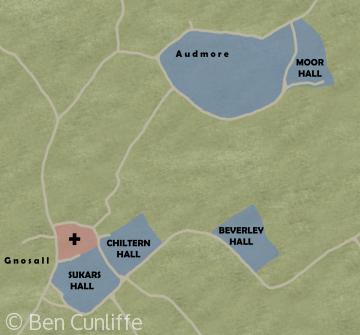Landscape of the Prebendal Manor of Gnosall

The earliest surviving record of Gnosall is in the Domesday Book of 1086, where the name is written as Geneshale. However, it is likely that Gnosall had been in existence for a long time prior to this date.
The place-name ‘Gnosall’ incorporates both native British and Old English elements describing the local topography. The place may have been originally called Geneu by the British, referring to the narrowing of a valley, of which there are several possible examples in the immediate vicinity. To this name was added the element halh; in this instance probably indicating ‘low-lying land by a river’.
By the time of the Domesday survey, Gnosall was a modestly sized settlement consisting of 8 ‘villein’ households - tenants who held land in return for labouring on behalf of their lord, and 4 ‘bordars’ or smallholders. Domesday records that there was sufficient arable land to keep two ploughs in work and that these local people had two ploughs. However, there seems to have been some over-capacity in this respect, because there were another four ploughs owned by the lords of the manor, presumably the nine priests.
There was a water mill for grinding corn. Gnosall seems to have been a fairly poor, but improving, community; its value had increased from 2 shillings in 1066 AD to 15 shillings in 1086 AD. However, this higher value only placed Gnosall in the middle of the range for the county as a whole, and Staffordshire was a relatively poor county.
The Domesday Book gives only a partial account of local agriculture, making no reference to other resources, such as pasture, meadow or woodland, yet it is clear that livestock farming was probably as important to the area as growing crops.
This work was carried out by the Staffordshire Community History Group, a project run by Staffordshire and Stoke on Trent Archive Service and the Victoria County History for Staffordshire



